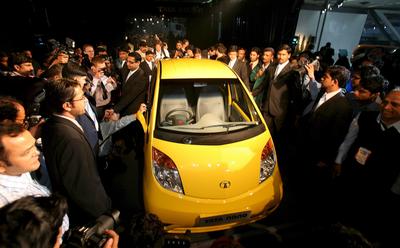But even these figures pale in comparison to the 30 per cent growth experienced in 2010, at which time interest rates were lower and the economy was booming, and the double-digit annual sales throughout the 2000s. No wonder global automakers scrambled to attend the 2012 Delhi Auto Expo earlier this year, where some 60 new models were launched.
Significantly, almost all cars sold in the country are now ‘made in India’, meaning they use between 70 and 98 per cent Indian components. The logic is simple: the more ‘Indian’ the car is, the cheaper it becomes, partly because it is cheap to manufacture cars in India, and partly because the tax structure is skewed in favour of domestic manufacturing. Economic analyst Jayanta Roy Chowdhury has argued that this is the result of shrewd planning by Indian policy makers, who in the 1990s lured global automakers to India with the bait of its huge domestic market, but cleverly brought in a tax structure that discourages imports of built-up and knocked-down car kits.
This policy brought automotive majors like General Motors, Honda, Mercedes Benz, Audi and the now-defunct Daewoo to India. These firms all made huge investments in setting up factories and developing Indian vendors who could eventually make quality spare parts. Thanks to this policy, India’s automotive industry today is worth an estimated US$35 billion and provides direct and indirect employment to over 13 million people.
India emerged as Asia’s fourth-largest exporter of passenger cars in 2009, behind Japan, South Korea and Thailand. It is estimated that India could be making five million cars by 2015, or seven million by 2020.
But even after taking into account a commensurately higher number of exports, most of these cars will still likely be driving on Indian roads. This raises an inevitable question: are there enough roads in India to take these vehicles?
While the automotive industry is booming, road and transport projects have not kept pace. Outside of the few key highways and roads in major cities, many Indians still commute using lanes and unpaved roads. The boom in the automotive sector is the direct consequence of poor public-transport infrastructure that has not kept up with India’s rapid urbanisation.
The national capital is the best example of how road and transport projects are now trying to keep up with the booming automotive industry. Ravaged and resurrected over centuries and sitting over the ruins of seven earlier cities, New Delhi has found its face changed in the last decade by railway engineer Elattuvalapil Sreedharan. New Delhi first came to realise its need for a mass rapid transit system in the early 1970s, but the ‘transport lobby’ of influential politicians caused delays. Many plans, studies and committees chased this for a full 25 years before the Delhi Metro Rail Corporation (DMRC) was formed. The lessons learnt from building the first metro helped Sreedharan build the DMRC from scratch. He demitted office last year after a 14-year stint, having changed the very definition of public transport in India.
At least 26 cities — including Chennai, Hyderabad and Bangalore — are now planning new metro systems. And Mumbai, perhaps the most congested and difficult to build, is already in the construction stage.
These metro systems are a great improvement and the visitor has a choice now: take a limousine or ride the swank Metro. But there is little doubt that investment in India’s public-transport infrastructure must continue to be expanded and gear up a notch if it is to keep pace with the booming automotive sector and help serve the country’s vast population.
Mahendra Ved is a New Delhi-based writer and columnist.
An earlier version of this article was originally published here in the New Strait Times.


I think that working on the infrastructure is very important in order to improve trade and make it easier for individuals to commute in India.
I think the problem’s basically the road and transport projects that didn’t improve through time. They must’ve missed the part where cars need to be driven through properly constructed roads, otherwise you’ll experience a bumpy ride, literally. Aside from that, cars may suffer from extreme damage.
I guess that’s the problem of a lot more countries.